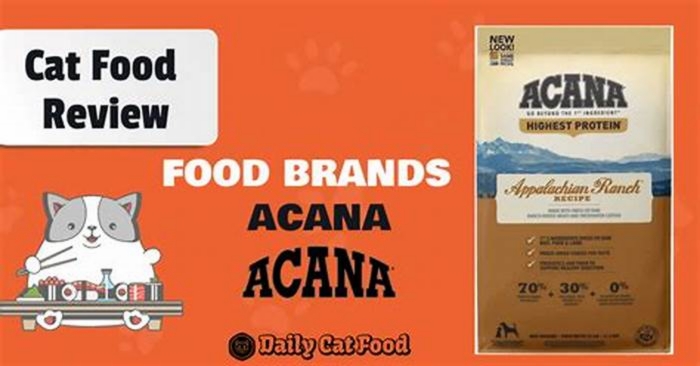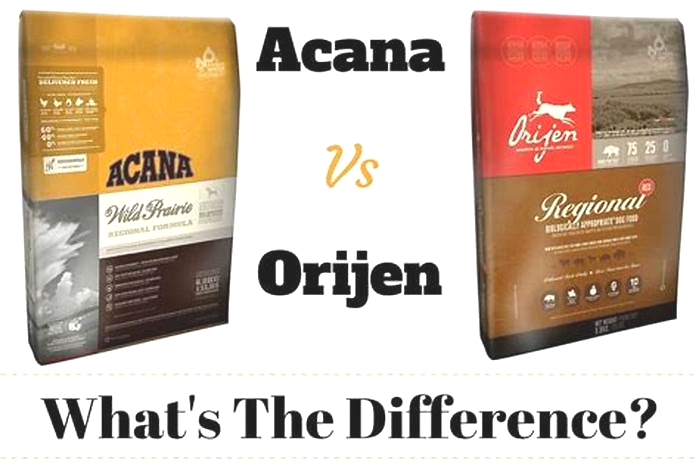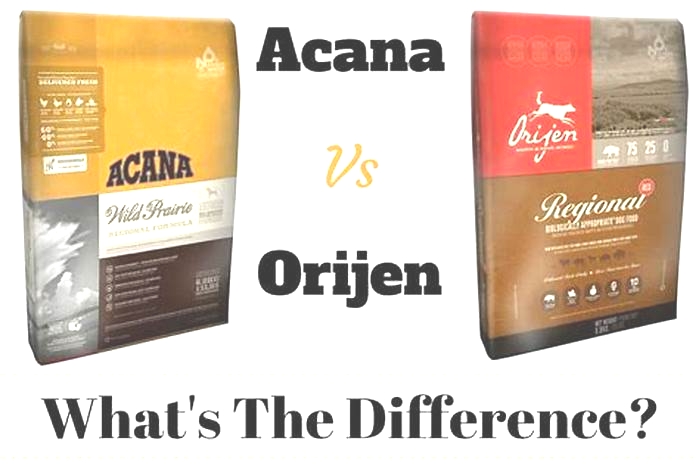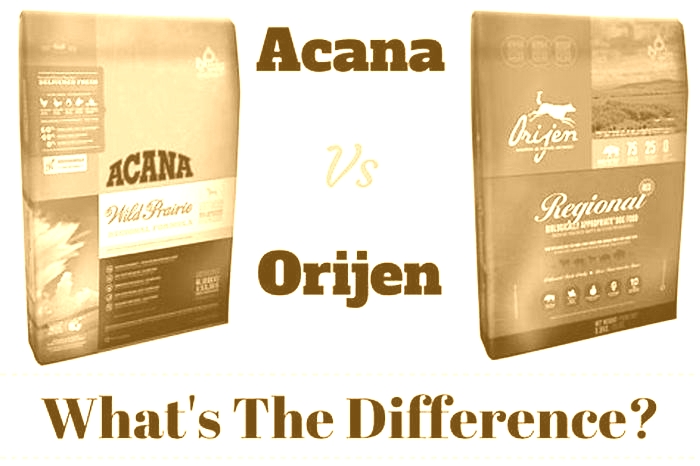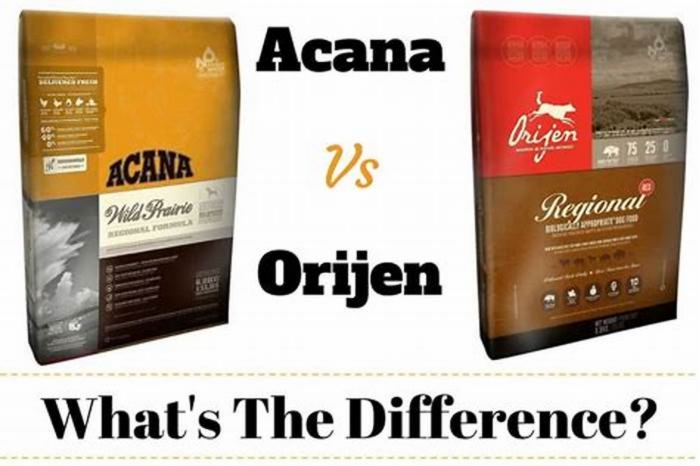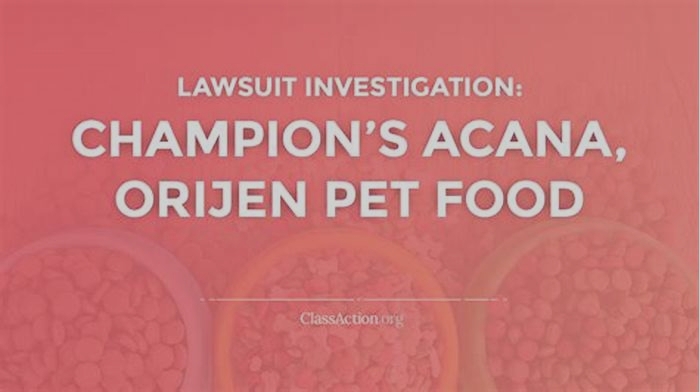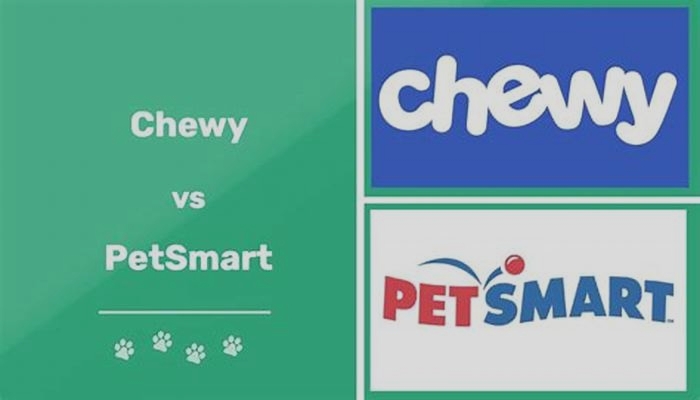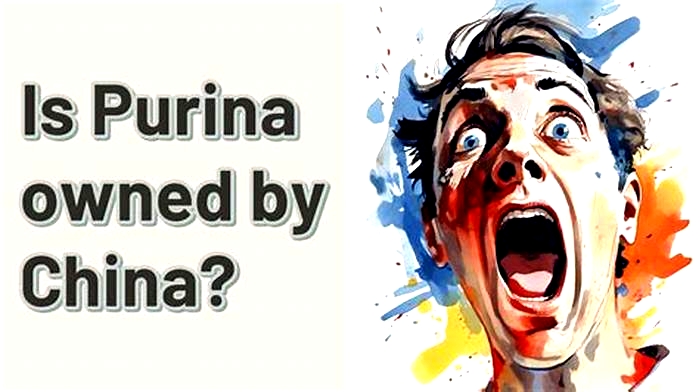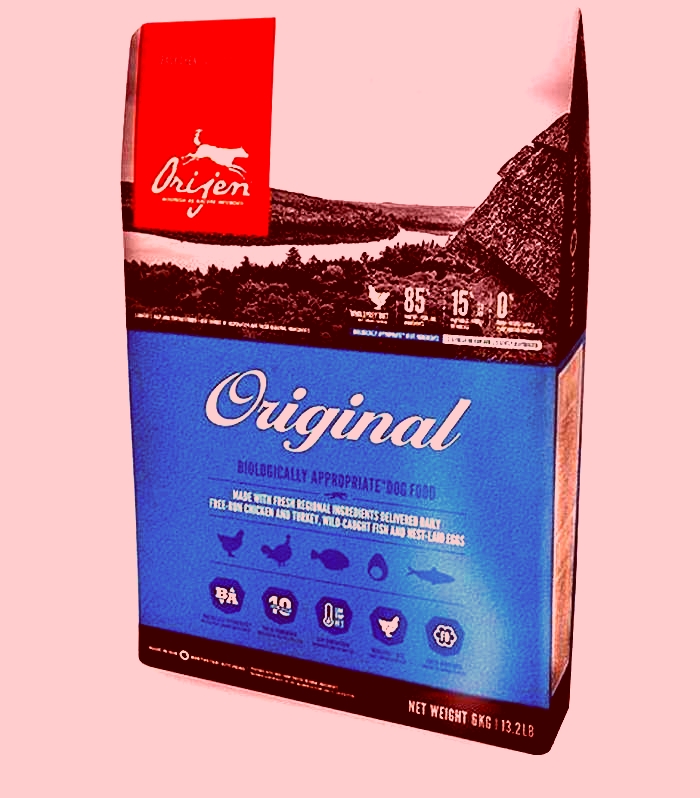Is Acana owned by ORIJEN
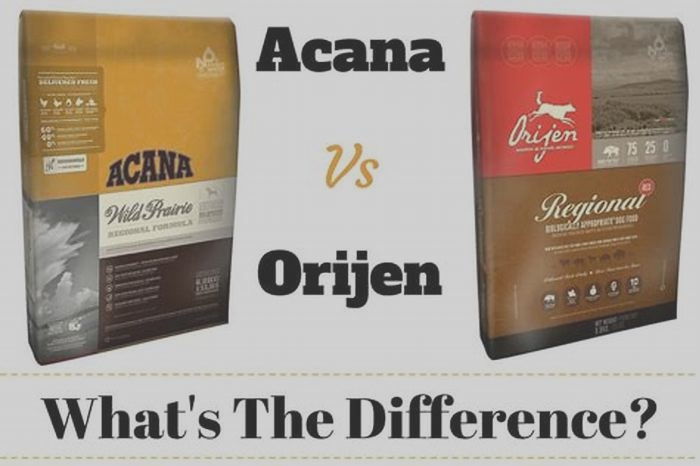
A chocolate company bought over ORIJEN & ACANA. Here is what you need to know.
The start of November has brought us the news that MARS, Incorporated, the worlds most lucrative company that owns 43% of the worlds pet food brands (and yes, the same company that makes Marsbar, Skittles, and M&M) is now officially the owner of Champions Petfoods.
If you have not heard of Champions Petfoods, you probably heard of two of their most successful products, ORIJEN & ACANA. They are some of the most popular premium grain-free pet food brands in the world. Since its inception in 1985, they have championed in the premium dog food market for biologically appropriate products that support pet health and wellness.
This news has brought two different reactions among dog owners.
For some people, this is very exciting as the company that owns household brands, such as Royal Canin and Pedigree, is expanding into the premium dog food market and by acquiring Champion Petfoods, they now have access to their technology and procedures, which they could apply in all their pet foods productions.
However, on the other side of the coin, the dog owners that have supported the brand are concerned that their beloved brand may no longer retain the same quality of food because big corporations will always have profit-first goals in mind, which means the ingredient will be changed and low-quality fillers will be added to the pet food to squeeze the cost. While Champion Petfoods has denied the claim under this Facebook comment, they certainly did not convince the brands supporters from feeling skeptical about the acquisition.
Ikdeep Singh, the global president of Mars Pet Nutrition, in a statement, said: We are thrilled to welcome Champion Petfoods and its more than 800 talented people to the Mars Petcare family. The Champion Petfoods team has been a pioneer in developing high-quality and premium pet food in the natural category that pet lovers around the world trust. Together, we will be even better positioned to support pet lovers and fulfill our purpose to create a better world for pets.
On the same note, Blaine McPeak, CEO of Champion Petfoods, stated: We are excited to join Mars Petcare and become part of a world leader in pet nutrition and services. This announcement is a wonderful way to recognize all the employees over our history who helped build Champion into a pre-eminent global pet food company with our incredible brands Orijen and Acana. We look forward to working with Mars Petcare on taking Champion to an entirely new level.
What do you think? Do you think this acquisition allows ACANA & ORIJEN to be more accessible to more people?
Let us know in the comment.
Furs Theoryprovides professional housecall dog grooming in Klang Valley. Our groomers are experienced and certified by top grooming academies in Malaysia.Talk to usto learn more about how housecall dog grooming saves you time as well as makes grooming an anxiety-free experience for your beloved dogs.
Acana vs Orijen Whats the Difference? Which is Best and Why?
This post may contain affiliate links. We may earn money or products from the companies mentioned in this post.
As a responsible pet owner, you want to do the right thing for your dog. Thats why picking the right food is so important.
Acana and Orijen both tout their dog foods as biologically appropriate and, in fact, both brands are made by the same company.
What is the difference between Acana and Orijen? And which is the best of the two?
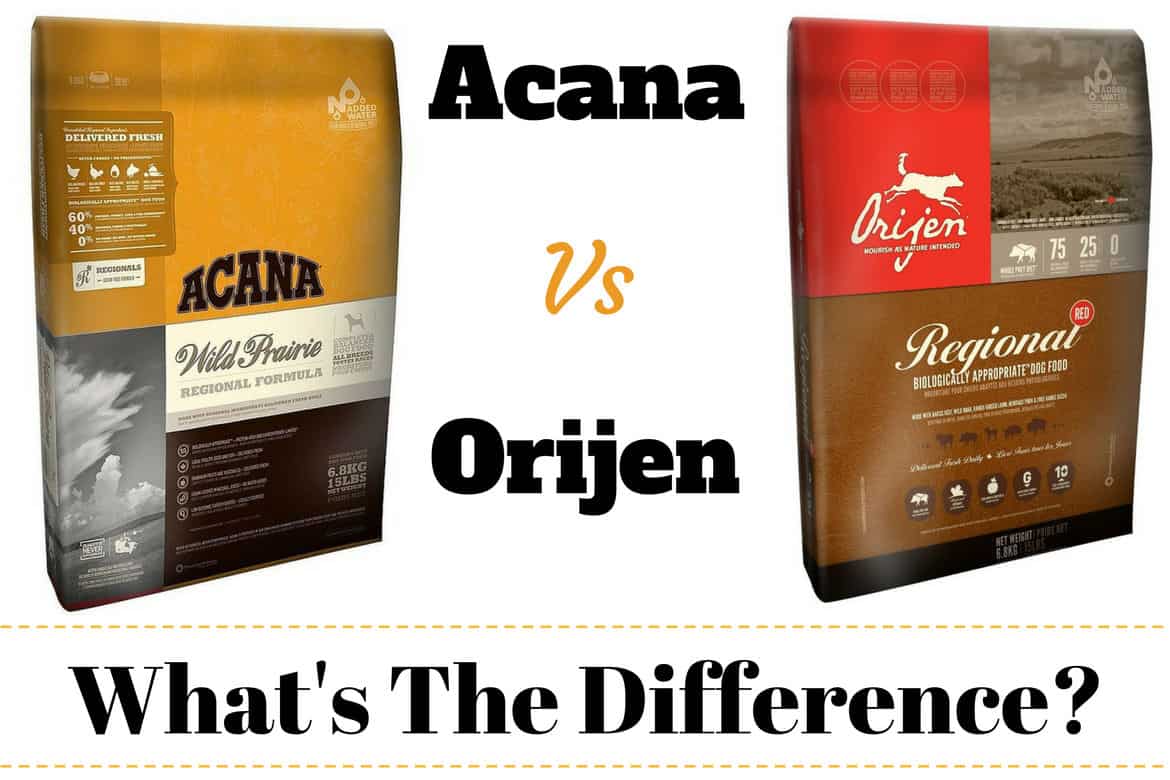
As usual, its not as simple as best and worst when it comes to dog food, as every animal is an individual, but well take a look at the differences between the two brands so hopefully, you can decide which would be better for your pup.
What Is Biologically Appropriate, Anyway?
Both Acana and Orijen claim to be biologically appropriate, but if youre not well-versed in dog food lingo, you might be wondering what this means.
The idea of food being biologically appropriate is based on the principle dogs havent changed all that much since they evolved from wolves and that they should be eating a similar diet.
According to the Acana website, The biologically appropriate concept is simple: mirror the quantity, freshness, and variety of meats that nature evolved dogs and cats to eat.
Of course, this is disputable, and many scientists sayit ignores tens of thousands of years of evolution and isnt based on sound logic. But, thats a debate for another day.
Whats The Difference In Variety Of Foods Available?
Orijen does only two main types of dog food: dry foodand freeze-dried food.
However, within these two types, there are seven varieties of dry food (some appropriate for puppies and senior dogs), and three varieties of freeze dried food.
The dry food is just like a regular kibble, whereas the freeze dried food can be rehydrated and treated like wet food.
In comparison, Acana has a slightly larger variety of foods available.
There is the Heritage range, which is high protein-low carbohydrate. There is the regionals range, which focuses on local meat and fish in the Kentucky area, where Acana is produced.
And, there is the singles range, which has only a single protein source, so its better for dogs with allergies or sensitive stomachs.
(Related post: Discover some of the best dog food for allergy sufferers)
Acana Vs Orijen: Whats The Difference In Meat Content Between Them?
On its website, Orijen explains the difference in meat content between Orijen and Acana.
Depending on the variety, each Orijen food contains between 75 and 80 percent meat, 50 percent of which is fresh meat.
Each type of Orijen food contains at least six different kinds of fresh meat and also takes on a whole prey model, meaning the foods contain things like organ meat, marrow, and cartilage, all of which wolves would eat in their natural diet.
Acana, on the other hand, contains between40 and 65 percent meat depending on the variety of which 9 to 30 percent is fresh meat.
There are at least three types of fresh meat in any given Acana food, but most of these foods dont contain whole prey ingredients.
You might also be interested in:
Whats the Difference in Proteinand Carbohydrate Content?
All foods from the Orijen brandcontain somewhere between 38 and 42 percent protein, whereas those that come from Acana contain between 25 and 35 percent protein.
Regarding carbohydrates, Orijen foods contain a maximum of 25 percent, and Arcana foods contain 25 to 30 percent.
Is There a Price Difference Between Acana and Orijen?
The different flavors and varieties of each food can vary significantly in price, but as a rule Acana is much more reasonably priced than Orijen.
For example, a 25lb bag of Acana Red Meat Formula will set you back around $70, whereas a 25lb bag of Orijen Regional Red is more than $115 including shipping.
Alternatives to Orijen and Acana
These two brands may be a bit hard to find. Click here for other great dog food brands that you may find more accessible.
Conclusion
So, what does all this mean? If youve been paying attention, its clear that Orijen foods are a slightly better quality that Acana.
For instance, Orijen foods contain more meat, more of which is fresh. But, Acana is more affordable than Orijen, meaning there may be some owners who cant stretch to Orijen but can afford Acana.
Its worth notingAcana foods are still extremely high quality for commercial dog foods and contain far higher quality ingredients than your average generic brand.
Now, what wed like to stress is, it doesnt necessarily follow that Orijen is better than Acana. Sure, its got higher protein and fewer carbs, but not all dogs thrive on a high protein diet.
Choosing the right food for your dog can involve a bit of trial and error, so all you can do is pick what you think theyll do best on and take it from there.
Please be aware this page contains affiliate links and LabradorTrainingHQ receives a small commission if you make any purchases through any such links.
This has absolutely no effect on the eventual price that you pay and we are very grateful for your support.
Top Picks For Our Dogs
- BEST PUPPY TOYWe Like: Calmeroos Puppy Toy w/ Heartbeat and Heat Packs - Perfect for new puppies. Helps ease anxiety in their new home.
- BEST DOG CHEWWe Like: Bones & Chews Bully Sticks - All of our puppies love to bite, nip, and chew. We love using Bully Sticks to help divert these unwanted behaviors.
- BEST DOG TREATS We Like: Crazy Dog Train Me Treats - One of our favorite treats for training our service dog puppies.
- BEST FRESH DOG FOOD We Like: The Farmer's Dog - A couple months ago we started feeding Raven fresh dog food and she loves it! Get 50% off your first order of The Farmer's Dog.
For a list of all the supplies we get for our new service dog puppies check out our New Puppy Checklist on the PuppyInTraining.com blog.
Acana vs Orijen Whats the Difference? Which is Best and Why? was last modified: June 16th, 2022 by Lauren Corona
Acana vs Orijen: 20 mini-reviews, and a Comprehensive Guide to Premium Dog Nutrition
In the vast landscape of dog food, the Acana vs Orijen debate frequently emerges as a focal point for those seeking the pinnacle of canine nutrition. Both Acana and Orijen stand tall as champions of the biologically appropriate dog food philosophy. But as we delve into the Acana vs Orijen comparison, what truly differentiates these two titans?
The term biologically appropriate signifies a commitment to replicating the diet of a dogs wild ancestors, emphasizing a meat-rich, protein-centric nutritional profile. Both Acana and Orijen, as stalwarts of this philosophy, ensure our furry friends receive nutrition thats not merely adequate but optimal for their evolutionary needs.
In our exploration of the Acana vs Orijen narrative, well discover that this philosophy translates to a high meat content, reflecting dogs carnivorous instincts. Both brands champion a diverse mix of fresh ingredients, spanning various meats, essential organs, cartilage, and bone, ensuring a comprehensive nutrient profile with minimal reliance on synthetic additives.
Another shared tenet in the Acana vs Orijen philosophy is the conscious limitation of carbohydrate content, mirroring the natural dietary inclinations of wild canines.
Having dedicated years to the study of canine nutrition, Ive been privy to the transformative benefits of a biologically appropriate diet. Dogs nurtured on such diets frequently exhibit enhanced vitality, radiant coats, robust skin, and an unmistakable zest for life. This embodies the Acana vs Orijen ethos its not merely about feeding but nourishing our pets with unparalleled excellence.
In this detailed guide, well not only delve into the Acana vs Orijen landscape but also embark on a meticulous comparison of their food ranges. Well conduct mini-reviews of each product, juxtapose the primary nutritional content of both brands, and evaluate their pricing strategies and reputations.
Acanas offerings, from its protein-rich Heritage range to the locally-sourced Regionals, will be weighed against Orijens diverse lineup, from the classic Orijen Original to specialized variants like Orijen Six Fish and Orijen Freeze-Dried Tundra.
With a rich background in pet nutrition and an unwavering commitment to the biologically appropriate approach, Im here to guide you through the intricate maze of Acana vs Orijen. Trust in my expertise as we journey together, aiming to discern the best nutritional path for your cherished canine companion
Variety of Foods Available in Acana vs Orijen
1. Orijen:
- Main Types of Dog Food:
- Dry Food:
- Freeze-Dried Food:
2. Acana:
- Main Ranges of Dog Food:
- Heritage Range: High protein and low carbohydrate.
- Regionals Range: Focuses on local meat and fish in Kentucky.
- Singles Limited Ingredient Range: Single protein source suitable for dogs with allergies or sensitive stomachs.
Mini-reviews:
Orijen

- Primary Ingredients: Chicken, Turkey, Flounder, Whole mackerel, Chicken liver, Turkey giblets (liver, heart, gizzard), Whole herring, Eggs, Dehydrated chicken, Dehydrated turkey.
- Protein Source: Multiple sources including chicken, turkey, flounder, mackerel, herring, and eggs.
- Grain-Free or Grain-Inclusive: Grain-Free.
- Nutritional Analysis: Approximately 38% protein and 18% fat, making it a high-protein formula ideal for active dogs. It also contains a mix of fresh fruits, vegetables, and botanicals that provide essential vitamins, minerals, and antioxidants.
- Pros:
- Made with fresh, regionally sourced ingredients.
- High protein content from diverse animal sources.
- Grain-free formula, ideal for dogs with grain sensitivities.
- Contains no fillers, artificial preservatives, or colorings.
- Includes a mix of fresh fruits and vegetables.
- Cons:
- Higher price point than some other brands.
- May not be suitable for dogs with certain protein sensitivities due to the diverse protein sources.
- The high protein content might not be ideal for less active or older dogs.

- Primary Ingredients: Whole Atlantic mackerel, whole Atlantic herring, monkfish, Acadian redfish, flounder, whole silver hake.
- Protein Source: Multiple fish sources including mackerel, herring, monkfish, redfish, flounder, and hake.
- Grain-Free or Grain-Inclusive: Grain-Free.
- Nutritional Analysis: Approximately 38% protein and 18% fat, emphasizing a high-protein formula derived from various fish sources. It also contains a blend of fresh fruits, vegetables, and botanicals that provide essential vitamins, minerals, and antioxidants.
- Pros:
- Made with fresh, regionally sourced fish ingredients.
- High protein content from diverse fish sources.
- Grain-free formula, ideal for dogs with grain sensitivities.
- Contains no fillers, artificial preservatives, or colorings.
- Rich in Omega-3 and Omega-6 fatty acids, beneficial for skin and coat health.
- Cons:
- Higher price point compared to some other brands.
- The distinct fish aroma might not be appealing to all dogs or pet owners.
- May not be suitable for dogs with certain fish sensitivities due to the diverse fish sources.
- Primary Ingredients: Chicken, Turkey, Flounder, Mackerel, Chicken liver, Turkey giblets (liver, heart, gizzard), Herring, Whole eggs, Dehydrated chicken, Dehydrated turkey
(Note: These are the top 10 ingredients listed, and the actual product contains more ingredients.)
- Protein Source: The primary protein sources in Orijen Regional Red are chicken, turkey, flounder, mackerel, and herring. These are quality items, but its important to note that raw poultry and fish contain up to 73% water. After cooking, the meat content is reduced to a fraction of its original weight.
- Grain-Free or Grain-Inclusive: Grain-Free
- Nutritional Analysis:
- Protein: 43% (dry matter basis)
- Fat: 21% (dry matter basis)
- Carbohydrates: Estimated at 28% (dry matter basis)
- Pros:
- Contains a liberal amount of named meats and organs as its dominant source of animal protein.
- Grain-free formulation.
- Enriched with chelated minerals for better absorption.
- Contains beneficial components like chicken liver and turkey giblets.
- Fish sources like flounder, mackerel, and herring are naturally high in protein and omega-3 fatty acids.
- No recalls noted for the brand.
- Cons:
- Raw poultry and fish ingredients contain a significant amount of water, which reduces the meat content after cooking.
- Contains various legumes like red lentils, pinto beans, green lentils, navy beans, chickpeas, and peas. While these are quality plant ingredients, theres an ingredient splitting concern. If combined, these legumes might occupy a higher position on the ingredient list, and they also contribute to the protein content, which might give a perception of higher meat content than there actually is.
- Overall Rating: Orijen Dog Food, including the Regional Red variant, receives the Advisors top rating of 5 stars and is enthusiastically recommended.

- Primary Ingredients: The primary ingredients in Orijen Tundra include a variety of meats and fish. The first two items listed are chicken and turkey. Following that, theres flounder and mackerel. Its important to note that raw poultry and fish contain a significant amount of water, which is lost during the cooking process. This means that the actual meat content in the finished product might be less than whats listed. Other notable ingredients include chicken liver, turkey giblets (liver, heart, gizzard), whole herring, and eggs.
- Protein Source: The main protein sources in this dog food are derived from chicken, turkey, flounder, mackerel, herring, and eggs. The dehydrated versions of these meats are also included, which are considered meat concentrates and contain a higher protein content than their fresh counterparts.
- Grain-Free or Grain-Inclusive: Orijen Tundra is grain-free. However, it does contain various legumes like red lentils, pinto beans, green lentils, navy beans, chickpeas, and peas. These legumes are a source of protein and fiber but also contribute to the carbohydrate content of the food.
- Nutritional Analysis:
- Protein: 43% (dry matter basis)
- Fat: 21% (dry matter basis)
- Carbohydrates: 28% (dry matter basis)
- Fiber: Estimated at 4.5% (dry matter content)
- Pros and Cons:
- Pros:
- High protein content from a variety of meat sources.
- Grain-free formulation suitable for dogs with grain sensitivities.
- Contains beneficial organ meats and whole eggs.
- Enriched with chelated minerals for better absorption.
- Cons:
- The presence of multiple legumes can be a concern for some pet owners due to potential ingredient splitting and the recent FDA investigation into a potential link between grain-free diets and canine heart disease.
- Overall rating: 5 stars
- Pros:

- Primary Ingredients: Chicken, turkey, flounder, whole mackerel, chicken liver, turkey giblets (liver, heart, gizzard), whole herring, eggs, dehydrated chicken, dehydrated turkey, dehydrated chicken liver, dehydrated egg, dehydrated mackerel, whole red lentils, whole pinto beans, chicken fat, whole green lentils, whole navy beans, whole chickpeas, lentil fiber, natural chicken flavor, whole peas, pollock oil, pea starch, chicken heart, whole pumpkin, whole butternut squash, collard greens, whole apples, whole pears, whole cranberries, dried kelp, salt, zinc proteinate, mixed tocopherols (preservative), vitamin E supplement, thiamine mononitrate, calcium pantothenate, copper proteinate, dried chicory root, turmeric, sarsaparilla root, althea root, rosehips, juniper berries, citric acid (preservative), rosemary extract, dried Lactobacillus acidophilus fermentation product, dried Bifidobacterium animalis fermentation product, dried Lactobacillus casei fermentation product.
- Protein Source: Chicken, turkey, flounder, mackerel, herring, eggs, and various dehydrated meats.
- Grain-Free or Grain-Inclusive: Grain-Free
- Nutritional Analysis:
- Protein (Dry Matter Basis): 43%
- Fat (Dry Matter Basis): 21%
- Carbohydrates (Dry Matter Basis): 28%
- Fiber (estimated dry matter content): 4.5%
- Pros:
- High-quality primary ingredients.
- Contains a variety of meats and fish as primary protein sources.
- Grain-free formulation.
- Contains beneficial supplements like chelated minerals for better absorption.
- Contains prebiotics to promote healthy gut bacteria.
- Cons:
- The presence of multiple legumes might be seen as ingredient splitting, which can artificially inflate the protein content from plant sources.
Rating: Orijen Fit & Trim receives a top rating of 5 stars.
- Primary Ingredients: Chicken, turkey, flounder, whole mackerel, chicken liver, turkey giblets (liver, heart, gizzard), whole herring, eggs, dehydrated chicken, dehydrated turkey.
- Protein Source: The primary protein sources are chicken, turkey, flounder, mackerel, and herring.
- Grain-Free or Grain-Inclusive: Grain-Free.
- Nutritional Analysis:
- Protein: 43% (dry matter basis)
- Fat: 21% (dry matter basis)
- Carbohydrates: Estimated 28% (dry matter basis)
- Pros:
- Contains a liberal amount of named meats and organs.
- Above-average protein content.
- Grain-free, which can be beneficial for dogs with grain sensitivities.
- Contains chelated minerals for better absorption.
- Cons:
- The presence of multiple legumes can be a concern for some dog owners due to potential ingredient splitting and the protein-boosting effect of legumes.
Rating: Orijen Puppy receives a top rating of 5 stars, indicating its an above-average dry dog food. The product is enthusiastically recommended
- Primary Ingredients: Fresh or Raw Chicken, Turkey, Salmon, Whole Herring, Chicken Liver.
- Protein Source: Primarily sourced from fresh or raw chicken, turkey, salmon, and herring.
- Grain-Free or Grain-Inclusive: Grain-Free.
- Nutritional Analysis:
- Crude Protein (min): 38%
- Crude Fat (min): 15%
- Crude Fiber (max): 8%
- Pros:
- High protein content supports muscle mass.
- Specifically formulated for senior dogs.
- Contains 85% animal ingredients.
- Mimics the natural diet of wild canines.
- Grain-free, which can be beneficial for dogs with grain sensitivities.
- Cons:
- Higher price point than some other brands.
- Some dogs might take time to adjust to the rich protein content.

- Type of Food: Freeze-Dried Dog Food
- Primary Ingredients: Chicken ground with bone, chicken liver, turkey, whole herring, eggs, pea fiber, turkey liver, turkey heart, flounder, chicken heart, whole pumpkin, collard greens, carrots, whole apples, salt, dried kelp, zinc proteinate, potassium chloride, manganese proteinate, copper proteinate, mixed tocopherols (preservative), vitamin E supplement.
- Protein Source: The primary protein sources are chicken (with ground bone), turkey, and herring.
- Grain-Free or Grain-Inclusive: Grain-Free.
- Nutritional Analysis:
- Protein: 29% (Calorie Weighted Basis)
- Fat: 60% (Calorie Weighted Basis)
- Carbohydrates: 11% (Calorie Weighted Basis)
- Fiber (estimated dry matter content): 5.2%
- Pros and Cons:
- Pros:
- High-quality animal-based protein sources.
- Grain-free formulation suitable for dogs with grain sensitivities.
- Contains beneficial organ meats and a variety of wholesome ingredients.
- Chelated minerals for better absorption.
- Cons:
- High fat content, which may not be suitable for all dogs.
- Some dogs might not prefer the taste of freeze-dried food.
- Pros:
- Type of Food: Freeze-Dried Raw Dog Food
- Primary Ingredients: Chicken ground with bone, chicken liver, turkey, whole herring, and eggs.
- Protein Source: Multiple sources including chicken, turkey, and herring.
- Grain-Free or Grain-Inclusive: Grain-Free
- Nutritional Analysis:
- Protein: 29% (Calorie Weighted Basis)
- Fat: 60% (Calorie Weighted Basis)
- Carbohydrates: 11% (Calorie Weighted Basis)
- Pros:
- High-quality raw ingredients.
- Multiple protein sources.
- Grain-free formulation suitable for dogs with grain sensitivities.
- Contains beneficial organ meats and fish rich in omega-3 fatty acids.
- Cons:
- High-fat content, which may not be suitable for all dogs.
- Lack of detailed ingredient list for the specific Regional Red variant.
- Rating: 3 out of 5 stars
- Type of Food: Freeze-Dried Raw Dog Food
- Primary Ingredients: Venison, duck (ground with bone), flounder, lamb, duck liver, herring, lamb liver, mutton, steelhead trout.
- Protein Source: Multiple sources including venison, duck, lamb, and fish.
- Grain-Free or Grain-Inclusive: Grain-Free
- Nutritional Analysis:
- Protein: 42% (dry matter basis)
- Fat: 35% (dry matter basis)
- Carbohydrates: Estimated 15% (dry matter basis)
- Fiber: Estimated 5.2% (dry matter basis)
- Pros:
- Contains a diverse range of high-quality animal proteins.
- Grain-free formulation suitable for dogs with grain sensitivities.
- Includes beneficial organ meats like liver.
- Contains no chicken or poultry by-products.
- Enhanced with fruits and vegetables for added nutrients.
- Cons:
- High fat content, which may not be suitable for all dogs.
- Some dogs might require an adjustment period when transitioning to this food.
- Price point might be higher compared to other dog foods.
- Rating: 3 out of 5 stars
Acana
- Type of Food: Dry Dog Food
- Primary Ingredients: Fresh chicken meat, chicken meal, turkey meal, red lentils, whole green peas.
- Protein Source: Chicken and turkey.
- Grain-Free or Grain-Inclusive: Grain-Free.
- Nutritional Analysis:
- Protein (Dry Matter Basis): 35%
- Fat (Dry Matter Basis): 19%
- Carbohydrates (Estimated Dry Matter Content): 38%
- Pros:
- Contains a significant amount of named meat meals as its dominant source of animal protein.
- Grain-free formulation.
- Includes a variety of quality ingredients such as fresh chicken, turkey, lentils, and peas.
- Contains chelated minerals for better absorption.
- Cons:
- Contains multiple legumes which can boost the protein content, making it essential to consider when judging the meat content.
- Ingredient splitting is present, which can misrepresent the actual content of certain ingredients.
Rating: 5 stars (as per Dog Food Advisor)
Rating: 5 stars
- Type of Food: Dry Kibble
- Primary Ingredients: Chicken, turkey, chicken meal, oat groats, whole sorghum.
- Protein Source: Chicken, turkey, and chicken meal.
- Grain-Free or Grain-Inclusive: Grain-Inclusive (contains oat groats and whole sorghum).
- Nutritional Analysis:
- Protein: 33%
- Fat: 19%
- Estimated Carbohydrates: 40%
- Pros:
- High meat content with chicken and turkey as the primary protein sources.
- Grain-inclusive but uses wholesome grains like oat groats and sorghum.
- Contains chelated minerals for better absorption.
- Cons:
- Contains multiple sources of plant-based protein from legumes.
- Ingredient splitting observed with the inclusion of various legumes.
Rating: 4 out of 5 stars
Acana Heritage Light & Fit is designed for overweight dogs. Its grain-free and uses a significant amount of named meat meals as its dominant source of animal protein, thus earning the brand a 5-star rating.
- Type of Food: Dry Dog Food
- Primary Ingredients: Deboned chicken, deboned turkey, turkey meal, chicken meal, whole red lentils, whole green peas, whole yellow peas, lentil fiber, chicken broth, whole eggs, chicken liver, pollock oil, pea starch, chicken fat, chicken heart, chicken cartilage, turkey liver, turkey heart, whole green lentils, whole pinto beans, whole chickpeas, natural chicken flavor, chicken liver freeze-dried, lentil fiber, whole pumpkin, whole butternut squash, mixed tocopherols (preservative), dried kelp, zinc proteinate, kale, spinach, mustard greens, collard greens, turnip greens, whole carrots, whole apples, whole pears, freeze-dried chicken liver, freeze-dried turkey liver, pumpkin seeds, sunflower seeds, niacin, thiamine mononitrate, copper proteinate, chicory root, turmeric, sarsaparilla root, althea root, rosehips, juniper berries, dried lactobacillus acidophilus fermentation product, dried bifidobacterium animalis fermentation product, dried lactobacillus casei fermentation product.
- Protein Source: Chicken, turkey, turkey meal, chicken meal.
- Grain-Free or Grain-Inclusive: Grain-Free
- Nutritional Analysis:
- Protein: 33% (dry matter basis)
- Fat: 15% (dry matter basis)
- Carbohydrates: 44% (dry matter basis)
- Pros:
- High-quality protein sources from deboned chicken and turkey.
- Grain-free formula suitable for dogs with grain sensitivities.
- Contains a variety of fresh fruits and vegetables.
- Enriched with essential vitamins, minerals, and antioxidants.
- Cons:
- Contains legumes which some believe might be linked to diet-induced heart disease in dogs (though this is still under investigation and not conclusively proven).
- Ingredient splitting with legumes might inflate the protein content from plant sources.
Rating: 5 stars

- Type of Food: Dry Dog Food
- Primary Ingredients: Deboned chicken, deboned turkey, chicken liver, turkey giblets, chicken meal, catfish meal, whole red lentils, whole pinto beans, whole green peas, pollock meal, chicken fat, whole green lentils, whole chickpeas, whole blue catfish, whole eggs, rainbow trout, pollock oil, lentil fiber, natural chicken flavor, chicken cartilage, turkey cartilage, choline chloride, whole pumpkin, whole butternut squash, mixed tocopherols (preservative), dried kelp, zinc proteinate, kale, spinach, mustard greens, collard greens, turnip greens, whole carrots, whole apples, whole pears, freeze-dried chicken liver, freeze-dried turkey liver, pumpkin seeds, sunflower seeds, niacin, thiamine mononitrate, copper proteinate, chicory root, turmeric, sarsaparilla root, althea root, rosehips, juniper berries, dried lactobacillus acidophilus fermentation product, dried bifidobacterium animalis fermentation product, dried lactobacillus casei fermentation product.
- Protein Source: Chicken, turkey, catfish, pollock, rainbow trout.
- Grain-Free or Grain-Inclusive: Grain-Free
- Nutritional Analysis:
- Protein: 33% (dry matter basis)
- Fat: 17% (dry matter basis)
- Carbohydrates: 42% (dry matter basis)
- Pros:
- Multiple high-quality animal protein sources.
- Grain-free formula suitable for dogs with grain sensitivities.
- Contains a variety of fresh fruits and vegetables.
- Enriched with essential vitamins, minerals, and antioxidants.
- Cons:
- Contains legumes which some believe might be linked to diet-induced heart disease in dogs (though this is still under investigation and not conclusively proven).
- Ingredient splitting with legumes might inflate the protein content from plant sources.
Rating: 4.5 stars

- Type of Food: Dry Dog Food
- Primary Ingredients: Deboned chicken, deboned turkey, chicken liver, turkey giblets, chicken meal, catfish meal, whole red lentils, whole pinto beans, whole green peas, pollock meal, chicken fat, whole green lentils, whole chickpeas, lentil fiber, whole blue catfish, cage-free eggs, rainbow trout, pollock oil.
- Protein Source: Chicken, turkey, catfish, pollock.
- Grain-Free or Grain-Inclusive: Grain-Free
- Nutritional Analysis:
- Protein (Dry Matter Basis): 38%
- Fat (Dry Matter Basis): 19%
- Carbohydrates (Estimated Dry Matter Content): 35%
- Pros:
- Contains a significant amount of named meats and meat meals as its primary source of animal protein.
- Grain-free formulation.
- Includes beneficial organ meats like chicken liver and turkey giblets.
- Contains chelated minerals for better absorption.
- Enriched with prebiotics for digestive health.
- Cons:
- Contains legumes which some believe can be linked to diet-related health issues in dogs (though no conclusive evidence).
- Ingredient splitting with legumes might inflate the protein content from plant sources.
Rating: 5 stars

- Type of Food: Dry Dog Food
- Primary Ingredients: Deboned chicken, deboned turkey, chicken liver, turkey giblets, chicken meal, catfish meal, whole red lentils, whole pinto beans, whole green peas, pollock meal.
- Protein Source: Chicken, turkey, catfish, pollock.
- Grain-Free or Grain-Inclusive: Grain-Free
- Nutritional Analysis:
- Protein: 38% (dry matter basis)
- Fat: 19% (dry matter basis)
- Carbohydrates: Estimated at 35% (dry matter basis)
- Pros:
- Contains a significant amount of named meats and meat meals as its dominant source of animal protein.
- Grain-free formulation.
- Contains chelated minerals for better absorption.
- Includes beneficial ingredients like chicory root which is a natural source of soluble dietary fiber and a prebiotic.
- Cons:
- The first two ingredients, chicken and turkey, are raw and contain up to 73% water. After cooking, their content is reduced significantly.
- Contains legumes like red lentils, pinto beans, and green peas which can boost protein content but are not a replacement for animal protein.
Rating: Acana Regionals Grasslands Dog Food receives a top rating of 5 stars
- Type of Food: Dry Dog Food
- Primary Ingredients: Deboned chicken, deboned turkey, chicken liver, turkey giblets, chicken meal, catfish meal, whole red lentils, whole pinto beans, whole green peas, pollock meal.
- Protein Source: Chicken, turkey, catfish, pollock.
- Grain-Free or Grain-Inclusive: Grain-Free
- Nutritional Analysis:
- Protein: 38% (dry matter basis)
- Fat: 19% (dry matter basis)
- Carbohydrates: Estimated 35% (dry matter basis)
- Pros:
- High-quality animal ingredients listed as primary ingredients.
- Grain-free formulation suitable for dogs with grain sensitivities.
- Contains a variety of protein sources, providing a diverse amino acid profile.
- Chelated minerals for better absorption.
- Contains prebiotics like chicory root to support gut health.
- Cons:
- Contains legumes, which some pet owners may be concerned about due to potential links to DCM (though no direct causation has been established).
- Ingredient splitting of legumes might inflate the protein content from plant sources.
Rating: 5 stars
- Type of Food: Dry Dog Food
- Primary Ingredients: Deboned duck, duck meal, duck liver, sweet potato, whole chickpeas, duck fat, whole lentils, lentil fiber, pollock oil, whole pears.
- Protein Source: Duck
- Grain-Free or Grain-Inclusive: Grain-Free
- Nutritional Analysis:
- Protein: 35% (dry matter basis)
- Fat: 19% (dry matter basis)
- Carbs: 38% (dry matter basis)
- Fiber: 5.7% (estimated dry matter content)
- Pros:
- High-quality primary ingredient (duck).
- Contains beneficial organ meat (duck liver).
- Grain-free formulation.
- Contains taurine, an important amino acid associated with heart health.
- Includes probiotics for digestive health.
- Contains chelated minerals for better absorption.
- Cons:
- Some may consider the legume content (chickpeas and lentils) as a potential protein booster, which might inflate the protein content from non-meat sources.
Rating: Acana Singles Dog Food receives the Advisors top rating of 5 stars.
- Type of Food: Dry Dog Food
- Primary Ingredients: Deboned pork, pork meal, whole lentils, pork liver, pork fat, whole peas, lentil fiber, butternut squash.
- Protein Source: Pork
- Grain-Free or Grain-Inclusive: Grain-Free
- Nutritional Analysis:
- Protein: 31% (dry matter basis)
- Fat: 17% (dry matter basis)
- Carbs: 44% (dry matter basis)
- Fiber: 6.7% (estimated dry matter content)
- Pros:
- High-quality primary ingredient (pork).
- Contains beneficial organ meat (pork liver).
- Grain-free formulation.
- Contains taurine, an important amino acid associated with heart health.
- Includes probiotics for digestive health.
- Contains chelated minerals for better absorption.
- Cons:
- Some may consider the legume content (lentils and peas) as a potential protein booster, which might inflate the protein content from non-meat sources.
Rating: Acana Singles Dog Food 5 stars.
- Type of Food: Dry Dog Food
- Primary Ingredients: Deboned beef, beef meal, whole lentils, beef liver, beef fat, whole peas, lentil fiber, pumpkin.
- Protein Source: Beef
- Grain-Free or Grain-Inclusive: Grain-Free
- Nutritional Analysis:
- Protein: 31% (dry matter basis)
- Fat: 17% (dry matter basis)
- Carbs: 44% (dry matter basis)
- Fiber: 6.7% (estimated dry matter content)
- Pros:
- High-quality primary ingredient (beef).
- Contains beneficial organ meat (beef liver).
- Grain-free formulation.
- Contains taurine, an important amino acid associated with heart health.
- Includes probiotics for digestive health.
- Contains chelated minerals for better absorption.
- Cons:
- Some may consider the legume content (lentils and peas) as a potential protein booster, which might inflate the protein content from non-meat sources.
Rating: Acana Singles Dog Food receives the Advisors top rating of 5 stars.
Meat Content Comparison: Acana vs Orijen
Orijen:
- High Meat Percentage: Orijen dog foods boast a remarkable meat content, ranging between 75 and 80 percent. This high percentage ensures that dogs receive ample protein from animal sources, which is essential for muscle development, energy, and overall health.
- Fresh Meat Inclusion: About half of the meat content in Orijen foods is fresh meat. Fresh meat provides essential nutrients in their most natural and bioavailable forms, ensuring that dogs receive the maximum nutritional benefits.
- Whole Prey Model: Orijen adheres to a whole prey philosophy. This means they include not just the muscle meat but also organ meat, marrow, and cartilage in their formulations. This approach mimics the natural diet of wild canids, providing a balanced intake of all the nutrients a dog would naturally consume.
- Benefits of Whole Prey Model: Organ meats are nutrient-dense and provide essential vitamins and minerals. Marrow is a rich source of healthy fats, and cartilage provides natural sources of glucosamine and chondroitin, which are beneficial for joint health.
Acana:
- Varied Meat Percentage: Acana dog foods have a meat content that varies between 40 and 65 percent. While this is lower than Orijen, its still considerably higher than many commercial dog foods on the market.
- Fresh Meat Inclusion: Acana includes fresh meat in their formulations, but the percentage can vary significantly, ranging from 9 to 30 percent. Fresh meat is a valuable source of protein and nutrients, and its inclusion ensures dogs receive a variety of meat-based nutrients.
- Limited Whole Prey Ingredients: Unlike Orijen, most Acana foods dont strictly adhere to the whole prey model. While they do include a variety of meat sources, they might not always incorporate organ meat, marrow, and cartilage to the same extent as Orijen.
- Benefits of Diverse Meat Sources: Even without the whole prey model, Acanas diverse meat sources ensure that dogs receive a broad spectrum of amino acids and other essential nutrients. The variety can also cater to dogs with specific dietary preferences or sensitivities.
In summary, while both Orijen and Acana prioritize high-quality meat sources, Orijen leans more towards a natural, ancestral diet with its whole prey model. Acana, on the other hand, offers a diverse range of meat sources, ensuring a balanced and varied nutrient profile. Both brands cater to different preferences and nutritional needs, making them top choices in the premium dog food market.
Protein and Carbohydrate Content Comparison: Acana vs Orijen
Orijen:
- High Protein Content: Orijen dog foods are renowned for their high protein content, which ranges between 38 and 42 percent. This high protein level is reflective of the brands commitment to mimic the natural diet of wild canids, ensuring dogs receive ample protein for muscle development, energy, and overall health.
- Protein Sources: The protein in Orijen foods primarily comes from high-quality animal sources, including various meats, fish, and poultry. The inclusion of fresh meat ensures that the protein is not only abundant but also of superior quality.
- Carbohydrate Content: Orijen foods contain a maximum of 25 percent carbohydrates. This relatively low carbohydrate content is in line with the brands philosophy of providing a diet thats closer to what dogs would naturally consume in the wild. The carbohydrates in Orijen foods come from wholesome sources like fruits, vegetables, and legumes.
Acana:
- Varied Protein Content: Acana dog foods offer a protein content that ranges between 25 and 35 percent. While this is slightly lower than Orijen, its still higher than many commercial dog foods on the market, ensuring dogs receive a substantial amount of protein for their dietary needs.
- Protein Sources: Acanas protein primarily comes from a diverse range of animal sources, ensuring a broad spectrum of amino acids and other essential nutrients. The brand emphasizes the use of fresh, regional ingredients, ensuring the protein is both abundant and of high quality.
- Carbohydrate Content: Acana foods contain between 25 to 30 percent carbohydrates. This range provides a balanced energy source for dogs without being excessively high. The carbohydrates in Acana foods are derived from nutritious sources, including various fruits, vegetables, and grains, ensuring dogs receive essential nutrients and dietary fiber.
In summary, while both Orijen and Acana prioritize high-quality protein sources, Orijen leans more towards a higher protein content, reflecting a more ancestral diet. Acana, on the other hand, offers a balanced protein and carbohydrate ratio, ensuring dogs receive both the protein they need for muscle and tissue repair and the energy they need for daily activities.
Both brands have formulated their foods based on extensive research and a deep understanding of canine nutrition, making them top choices for pet owners seeking premium dog food.
Price Comparison: Acana vs Orijen
Factors Influencing Price:
- Ingredient Quality: Both Orijen and Acana prioritize high-quality, fresh, and regional ingredients. The cost of sourcing these premium ingredients, especially in the quantities and varieties they use, can significantly influence the final products price.
- Production Processes: Orijen and Acana are produced in Champion Petfoods state-of-the-art kitchens. The advanced processing methods, quality checks, and safety protocols can add to the production costs.
- Brand Philosophy: Orijens philosophy leans towards providing a diet that closely mimics the natural diet of wild canids, which means a higher meat content and a diverse range of fresh ingredients. This can make Orijen products more expensive to produce compared to Acana, which, while still premium, offers a more balanced approach to canine nutrition.
Price Points:
- Acana: Acana is positioned as a premium dog food brand, but its generally more affordable than Orijen. A 25lb bag of Acana Red Meat Formula, for instance, is priced around $70. The price reflects the brands commitment to quality while also offering value to pet owners. Acanas diverse range of formulas also means theres a variety of price points to fit different budgets.
- Orijen: Orijen is positioned at the higher end of the premium dog food market. A 25lb bag of Orijen Regional Red, as an example, can be priced over $115, including shipping. The price point reflects the brands emphasis on a high meat content, diverse fresh ingredients, and a diet thats closely aligned with what dogs would consume in the wild.
Considerations for Pet Owners: Acana vs Orijen
- Cost vs. Value: While Orijen might come with a higher price tag, its essential to consider the value it offers in terms of ingredient quality, nutritional profile, and the potential health benefits for the dog.
- Dietary Needs: Depending on a dogs specific dietary needs, life stage, and health conditions, one brand might offer a formula thats more suitable than the other, influencing the purchasing decision beyond just the price.
- Frequency of Purchase: While the upfront cost might seem higher, its essential to consider how long a bag lasts. Higher-quality foods might be more nutrient-dense, meaning you might feed less daily, making the bag last longer.
Reputable Endorsements
Both Acana and Orijen align their formulations with guidelines set by reputable organizations like the Association of American Feed Control Officials (AAFCO). Such endorsements add a layer of trust when comparing Acana vs Orijen.
Conclusion

In the realm of premium dog food, both Acana and Orijen have carved out significant niches for themselves, offering top-tier nutrition tailored to the natural dietary needs of dogs. However, when diving deeper into the specifics, some distinctions might sway pet owners in one direction over the other.
Orijen stands out for its higher protein content, often ranging between 38% to 42%. This makes it an excellent choice for active dogs or those breeds that naturally require more protein in their diet. The brands commitment to using fresh, regional ingredients and its whole prey approach ensures a comprehensive nutrient profile without heavy reliance on synthetic additives.
On the other hand, Acana, while still high in protein, offers a slightly more varied range in terms of protein content, making it a versatile choice for dogs with different activity levels and dietary needs. Acanas diverse ranges, from Heritage to Regionals and Singles, allow pet owners to choose a formula that best matches their dogs specific requirements, be it a single protein source for sensitive stomachs or a high-protein diet for active pups.
Price-wise, Acana tends to be more pocket-friendly compared to Orijen. For pet owners on a budget but still wanting premium nutrition, Acana might be the more appealing choice.
In conclusion, if youre looking for the highest protein content and a diet that closely mirrors the wild, Orijen might be the better pick. However, if youre seeking versatility, a slightly more affordable price point, and still want top-notch ingredients, Acana could be the way to go. As always, its essential to consider your dogs unique needs, activity levels, and any specific dietary requirements when making your final decision.
Whats Next?
Whats Next for Your Furry Friend?
- Are you impressed with our insights? Delve deeper into the world of canine nutrition with our detailed brand comparison reviews.
- Are you curious about specific dog food brands? Please navigate through our comprehensive brand reviews to find the perfect match for your pet.
- Is your dog facing unique dietary challenges? Uncover the ideal solutions with our targeted dog food reviews tailored to specific needs.
- Are you thinking of enhancing your dogs meals? Elevate their diet with our expertly curated dog food supplement guides.
- Want to stay updated? Join our community and subscribe to our newsletter for tips, reviews, and canine nutrition news.
At the core of our philosophy is a simple truth: Good Nutrition is the Foundation of a Happy Dog. When our dogs thrive, it brings unparalleled joy and happiness into our lives. Lets embark on this journey of optimal nutrition and well-being together

